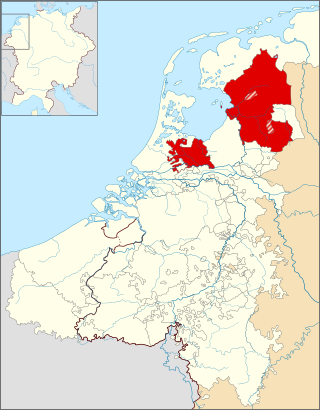
The Bishopric of Utrecht was an ecclesiastical principality of the Holy Roman Empire in the Low Countries, in the present-day Netherlands. From 1024 to 1528, as one of the prince-bishoprics of the Holy Roman Empire, it was ruled by the bishops of Utrecht.
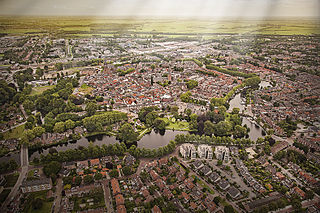
Woerden is a city and a municipality in central Netherlands. Due to its central location between Amsterdam, Rotterdam, The Hague, and Utrecht, and the fact that it has rail and road connections to those cities, it is a popular town for commuters who work in those cities.

Floris V reigned as Count of Holland and Zeeland from 1256 until 1296. His life was documented in detail in the Rijmkroniek by Melis Stoke, his chronicler. He is credited with a mostly peaceful reign, modernizing administration, policies beneficial to trade, generally acting in the interests of his peasants at the expense of nobility, and reclaiming land from the sea. His dramatic murder, said by some to have been arranged by King Edward I of England and Guy, Count of Flanders, made him a hero in Holland.

The Amstel is a river in the province of North Holland in the Netherlands. It flows from the Aarkanaal and Drecht in Nieuwveen northwards, passing Uithoorn, Amstelveen, and Ouderkerk aan de Amstel, to the IJ in Amsterdam, to which the river gives its name. Annually, the river is the location of the Liberation Day concert, Head of the River Amstel rowing match, and the Amsterdam Gay Pride boat parade.

The House of Egmond or Egmont is named after the Dutch town of Egmond, province of North Holland, and played an important role in the Netherlands during the Middle Ages and the Early modern period. The main lines Egmond-Geldern, Egmond-Gavere and Egmond-Buren-Leerdam had high noble, princely rank.

Muiden Castle is a castle in the Netherlands, located at the mouth of the Vecht river, some 15 kilometers southeast of Amsterdam, in Muiden, where it flows into what used to be the Zuiderzee. It is one of the better known castles in the Netherlands and featured in many television shows set in the Middle Ages.

Gijsbrecht van Aemstel is a 17th-century history play by Joost van den Vondel, written to inaugurate Amsterdam's first city theatre. The first production was planned to take place on 26 December 1637, but was postponed until 3 January 1638. The piece was then performed annually in Amsterdam until 1968.

Gijsbrecht IV of Amstel or Gijsbrecht IV van Amstel was a powerful lord in the medieval County of Holland and a member of the Van Aemstel family. His territory was Amstelland, and his son was Jan I of Amstel.

The Lords of Brederode were a noble family from Holland who played an important role during the Middle Ages and the Early modern period. The family had a high noble rank and hold the titles Count of Brederode, Count of Gennep, and furthermore they ruled the souverain Lordship of Vianen, the Viscountship of Utrecht among other feudal titles.

John of Nassau, German: Johann von Nassau, Dutch: Jan van Nassau was a clergyman from the House of Nassau. From 1267 to 1290 he was Bishop-Elect of the Bishopric of Utrecht as John I. He did not care much for his spiritual functions, and his government also failed due to his weak political and poor financial management. During his reign, the influence of the County of Holland in the Bishopric greatly increased. John's government was one of the worst the Bishopric had to endure; without talent and energy, slavishly surrendering to all sensual pleasures, it was never possible for him to maintain the inner peace, under which the Nedersticht in particular suffered greatly.
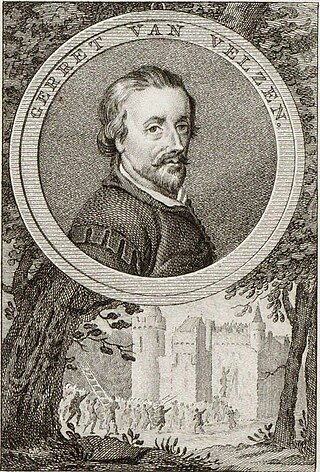
Gerard de van Velzen was lord of Beverwijk, Noordwijk, and Velsen.
Herman VI van Woerden was a lord of Woerden.
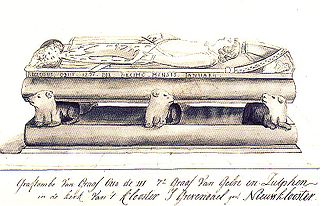
Otto II, Count of Guelders was a nobleman from the 13th century. He was the son of Gerard III, Count of Guelders and Margaretha of Brabant.

John I, Lord of Egmond was Lord of Egmond, Lord of IJsselstein, bailiff of Kennemerland (1353–1354) and stadtholder of Holland.

Tongelaar Castle is located between Mill and Gassel in North-Brabant, Netherlands.

Willem V of Horne was a medieval nobleman.

Dirk Loef of Horne was a medieval nobleman.
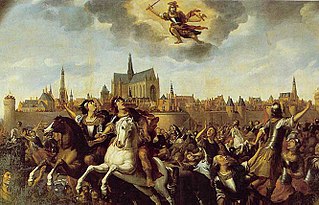
The Kennemer uprising was a rebellion of farmers in the County of Holland and Prince-Bishopric of Utrecht in the Holy Roman Empire, that took place between 1272 and 1274. The commoners or huislieden from the Kennemerland, a bailiwick within the County of Holland, rose up against their bailiff and the other nobles. The movement spread to the nearby West Friesland, Waterland and Amstelland. The lord of Amstelland, Gijsbrecht IV of Amstel decided to join the insurrenction and became the leader of the Kennemers. Later Utrecht, Amersfoort and Eemland also joined. Eventually, the Kennemers were defeated.

The siege of Montfoort took place in 1280 when Count Floris V of Holland attacked the castle of lord Herman VI van Woerden at Montfoort in the Prince-Bishopric of Utrecht. The siege ended after half a year when the soldiers inside the castle surrendered. The primary source for the siege is the Rijmkroniek van Holland by Melis Stoke.

The siege of Vredelant took place from late 1279 to 1280 and was fought between Floris V of Holland and Bishop-Elect John I of Nassau on one side and the rebellious Van Amstel family on the other side. The castle of Vredelant was taken within weeks when Gijsbrecht IV van Amstel was captured by the count's soldiers.




















